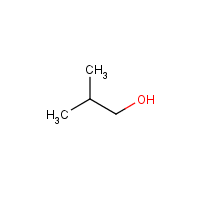Isobutyl alcohol
Agent Name
Isobutyl alcohol
Alternative Name
Isobutanol
CAS Number
78-83-1
Formula
C4-H10-O
Major Category
Solvents

Synonyms
1-Hydroxymethylpropane; 1-Propanol, 2-methyl-; 2-Methyl propanol; 2-Methyl-1-propanol; 2-Methylpropyl alcohol; Alcool isobutylique [French]; Fermentation butyl alcohol; Isobutanol; Isobutyl alcohol; Isobutyl alcohol (natural); Isobutylalkohol [Czech]; Isopropylcarbinol; [ChemIDplus] UN1212
Category
Alcohols (<C12)
Description
Colorless, oily liquid with a sweet, musty odor; [NIOSH]
Sources/Uses
Used as solvent in lacquers, paint removers, and liquid chromatography; used in organic synthesis; [ACGIH]
Comments
In mice, 6400 ppm produces narcosis, but not death. [ACGIH] A skin, eye, and respiratory tract irritant; Inhalation of high concentrations can cause CNS depression; [ICSC]
Biomedical References
Exposure Assessment
Skin Designation (ACGIH)
Insufficient data
TLV (ACGIH)
50 ppm
PEL (OSHA)
100 ppm
MAK
100 ppm
IDLH (NIOSH)
1600 ppm
Excerpts from Documentation for IDLHs
Basis for original (SCP) IDLH: The chosen IDLH is based on the statement by Patty [1963] that 2 of 6 rats died when exposed for 4 hours to 8,000 ppm [Smyth et al. 1954]. . . . Human data: None relevant for use in determining the revised IDLH.
Vapor Pressure
10.4 mm Hg
Odor Threshold Low
0.66 ppm
Odor Threshold High
40 ppm
RD50
1818 ppm
Lethal Concentration
LCLo (rat) = 8,000 ppm/4H
Explanatory Notes
Detection odor threshold from AIHA (mean = 3.6 ppm); Flash point = 82 deg F; VP from HSDB;
NFPA
may ignite at ambient temp
Adverse Effects
Neurotoxin
Acute solvent syndrome
Diseases, Processes, and Activities Linked to This Agent
Diseases
Occupational diseases associated with exposure to this agent:
Processes
Industrial Processes with risk of exposure: